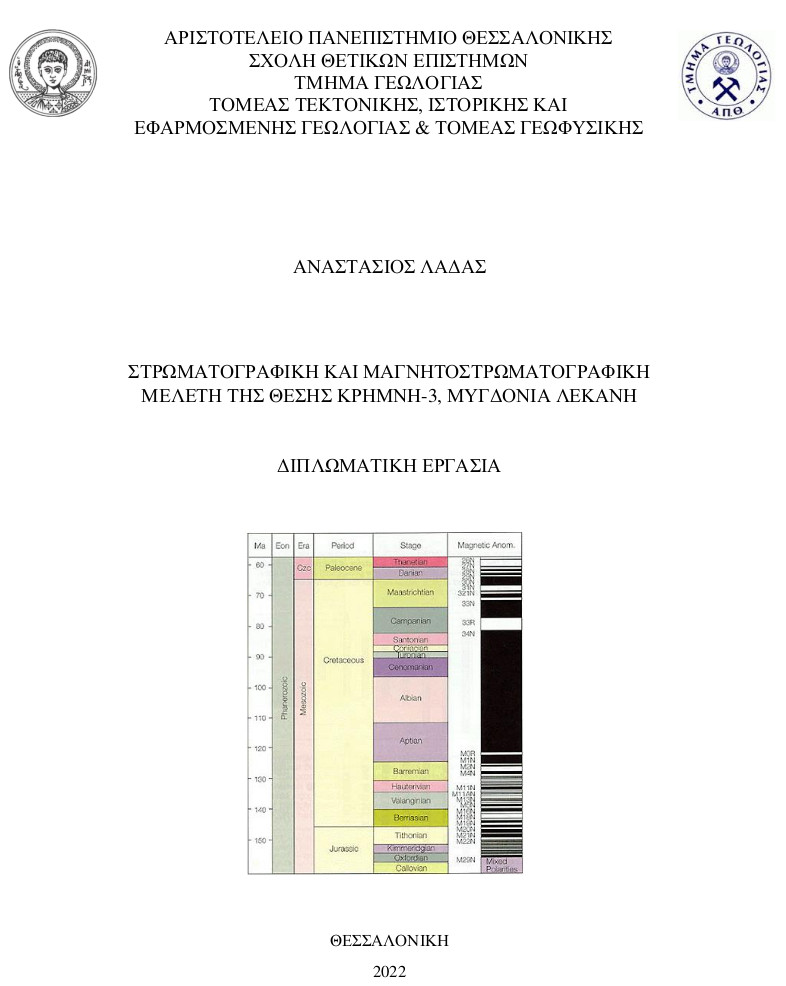
Στρωματογραφική και Μαγνητοστρωματογραφική μελέτη της θέσης Κρήμνη-3, Μυγδονία λεκάνη = Stratigraphic and Magnetostratigraphic study on the Krimni-3 locality, Mygdonia basin.
Περίληψη
Η παρούσα πτυχιακή εργασία αποτελεί μια προσπάθεια λεπτομερούς καταγραφής της στρωματογραφίας της απολιθωματοφόρου θέσης Κρήμνη-3, στην Μυγδονία λεκάνη, και παράλληλα μία διερεύνηση των παλαιομαγνητικών ιδιοτήτων των αποθέσεων προκειμένου να χρονολογηθεί η θέση με βάση τις αρχές της μαγνητοστρωματογραφίας. Οι αποθέσεις της περιοχής μελέτης ανήκουν στα ανώτερα στρώματα του Σχηματισμού Γερακαρούς και η μελέτη τους έδειξε την παρουσία 5-9 διακριτών λιθοστρωματογραφικών ενοτήτων πλην του εδαφικού καλύμματος. Ανάλυση χαρακτηριστικών δομών φανερώνει έντονες οξειδωτικές συνθήκες, σε ένα περιβάλλον με υψηλές θερμοκρασίες και χαμηλή υγρασία που πιθανά ανταποκρίνεται σε εκείνο ενός μαιανδρικού ποταμού. Η παλιαομαγνητική μελέτη που πραγματοποιήθηκε έδειξε ότι τα δείγματα ήταν ασθενώς μαγνητισμένα και δεν μπόρεσαν να καταγράψουν ικανοποιητικά την διεύθυνση του μαγνητικού πεδίου κατά την απόθεσή τους, ενώ το κύριο μαγνητικό ορυκτό είναι ο αιματίτης.
This diploma thesis is an attempt at detailing and recording the stratigraphy of the fossiliferous locality Krimni-3, in Mygdonia basin, while at the same time analyzing the paleomagnetic properties in order to date the locality according to the principles of magnetostratigraphy. The sediments of the research area belong to the uppermost layers of the Gerakarou Formation and studying them revealed the presence of 5-9 distinct lithostratigraphic units, excluding the soil covering them. Analysis of characteristic structures reveals heavy oxidation conditions, in an environment with high temperatures and low humidity, that possibly corresponds with that of a meandering river. The paleomagnetic research that was conducted showed that the samples were only slightly magnetized and couldn’t properly depict the direction of the magnetic field while being deposited, with the main magnetic mineral being hematite.
Πλήρες Κείμενο:
PDFΑναφορές
Alonso-Zarza, A.M., and Tanner, L.H., Developments in Sedimentology 61: Carbonates in Continental Settings, The Netherlands, Elsevier, 2010, 225-267.
Borsi et al. 1964-65: Sur l’âge absolu des séries métamorphiques du massif serbo-macédonien au NE de Thessaloniki (Grèce). Ann. Soc. Geol. Du nord., LXXXIV, 223-225, Lille.
Einsele, G., Sedimentary basins: evolution, facies, and sediment budget, Springer-Verlag Berlin Heidelberg GmbH, 2000, pp. 29-51.
Georgalas, G. and Galanopoulos, A., 1953: Das groesse Erdbeden der Chalkidike vom 26 September 1932. Bull. Geol. Soc. Greece, 1, 1, 11-65.
Kockel et al., 1971: Geologie des Zerbo-mazdonischen massivs und seines mesozioschen Rahmens (Nordgriechenland). Geol. JB., 89, 529-551, Hannover.
Kockel, F., and Mollat, H., 1977: Erläuterungen zur Geologischenn Karte der Chalkidiki und angrenzender Gebiete 1:100.000 (Nord-Griechenland). Bundesnastalt für Geowissenschaften und Rohstoffe: 1-119.
Koliadimou, K.K., Koufos, G., 1998: Neogene/Quaternary micromammals from Mygdonia Basin (Macedonia, Greece). Rom. J. Stratigraphy 78, 75-82.
Konidaris, G.E. et al., 2015: Two new vertebrate localities from the Early Pleistocene of Mygdonia Basin (Macedonia, Greece): preliminary results. Comptes Rendus Palevil 14: 253-362.
Konidaris, G. et al. 2021: Dating of the Lower Pleistocene vertebrate site in Tsiotra Vryssi (Mygdonia Basin, Greece): biochronology, magnetostratigraphy and cosmeogenic radionuclides. Quaternary 4: 1-18.
Kostopoulos, D. et al. 2022: The new fossil site Krimni-3 in Mygdonia Basin and the first evidence of a giant ostrich in the Early Pleistocene of Greece. Pal. Zeitschrift (in press).
Koufos G. et al., 1995: Preliminary Results about the stratigraphy and the palaeoenvironment of Mygdonia Basin, Macedonia, Greece. Geobios. Mem. Spec. 18, 243-249.
Koufos, G., Kostopoulos, D., 2013: First report of Brachypotherium Roger 1904 (Rhinocerotidae, Mammalia) in the Middle Miocene of Greece. Geodiversitas 35. 629-641.
Koufos, G. and Kostopoulos, D., 2016: The Plio-Pleisotocene large mammal record of Greece: implications for eartly human dispersals into Europe. In Paleoanthropology of the Balkans and Anatolia, ads. K. Harvati, and M. Daksandic, 269-280. Dordrecht: Springer.
Koufos G. Syrides. G. and Koliadimou K., 1989: A new Pleistocene mammal locality from Macedonia (Greece). Contribution t the study of Villafrannchian (Villanyian) in Central Macedonia. Bulletin of the Feological Society of Greece, 23: 113-124.
Langereis et al., 2010. Magnetostratigraphy – concepts, definitions, and applications. Newsletter on Stratigraphy, vol. 43/3, 207-233.
Maravelakis, M., 1936: Σπουδή επί των σεισμών της Χαλκιδικής Ο κρυσταλλοπαγής όγκος Βερτίσκον και αι πέριξ αυτού θέρμαι. Προ και μετασεισμική κατάστασις αυτών. Εργαστήριο Ορυκτολογίας-Γεωλογίας-Πετρολογίας, Πανεπιστήμιο Θεσσαλονίκης αρίθ. 7, 1-43, Θεσσαλονίκη.
Mercier, J., 1966: Movements orogeniques at magmatise d’âge jurasique supérieur – éocrétacé dans les zones internes des Hellénides (Macedoine, Grèce). Rev. Geogr. Phys. et Géol. Dyn., VIII, 265-275, Paris.
Neubauer, W.H., 1957: Die südgrenze der Rodopen. Ein Beitraz zur stratigraphischen Auflösung den Kristalline der Halbinsel Chalkidikie. Sb. Ak. Wiss., Abt. 1, 13 d., 166, 1-18, Wien.
Osswald, K., 1938: Geologische Geschichte von Griechisch-Nordmakedonien. Denkschr. der geol. Landesanstalt von Griechenland. Heft 3, Athen.
Psilovikos, A., 1977: Palaeogeographic development of the basin and lake of Mygdonia (Lagada-Volvi area), Greece. Aristotle University of Thessaloniki, Thessaloniki.
Psilovikos A. and Sotiriades L., 1983: The neotectonic graben complex of the Serbomacedonian massif at the area of Promygdonia Basin in northern Greece. Claust. Geol. Abh., 44: 22-52.
Tsoukala, E., Chatzopoulou, K., 2005. A new Early Pleistocene (Latest Villafranchian) site with mammals in Kalamoto (Mygdonia Basin, Macedonia, Greece) –preliminary report. Mitt. Komm. Quartärforsch. Österr. Akad. Wiss. 14, 213-233.
Εισερχόμενη Αναφορά
- Δεν υπάρχουν προς το παρόν εισερχόμενες αναφορές.
